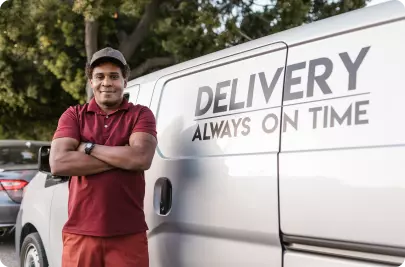What Is Route Management? A Complete Guide For Growing Delivery Businesses

Route management software helps delivery businesses plan efficient multi-stop routes in minutes instead of hours. By optimizing delivery sequences, businesses reduce fuel costs, driver time, and vehicle wear by up to 30%—critical for operations that can't afford to waste resources as they scale.

- Manual route planning fails beyond 20 stops. The number of possible sequences makes human optimization mathematically impossible.
- Route management software reduces total distance traveled by up to 30%, cutting fuel costs, driver wages, and vehicle wear
- The benefits are immediate: Businesses report going from 4+ hours of planning to 3 minutes.
- Modern route management software is affordable even for small operations with 1-2 vehicles.
- Better route sequencing also improves customer satisfaction through accurate ETAs instead of vague delivery windows.
4P Foods had the kind of problem businesses love to have: they were growing too fast. Every day, they deliver fresh produce from hundreds of independent farmers to customers across the eastern seaboard of the US. Demand for local fresh produce surged through the pandemic, leading to an influx of new customers — but also a lot of pressure on the team to maintain a delivery service that could get produce to customers as fresh as it left the farm.
Route management at 4P Foods was done manually, and neither their planning systems nor their drivers could keep up with the new demand. “We couldn’t route 1,000 stops by hand,” said Operations Manager Justin White. “That’s when we knew we needed software to help”. Drivers were resistant to the idea at first, but became enthusiasts after White introduced Routific route management software. “The first time the drivers came back from a route, our lead driver said: ‘We should’ve done this a long time ago’.”
So if you’re still doing manual route management — there’s a golden opportunity to streamline your processes and improve your profitability. But first, let’s dive into some basics!
(Already convinced? Try Routific free for 7 days right now — no phone number or credit card needed!)
What is route management?
Route management is the practice of planning and optimizing sales, service and delivery routes for maximum efficiency. It often includes driver scheduling as well.
Traditionally route managers have done their jobs using a combination of customer lists, maps, and years of accumulated knowledge about local roads and traffic. In the early 2000s, some turned to spreadsheets and apps like Google Maps for their route planning. Nowadays specialist route optimization software helps route managers handle more routes and more stops than ever before, while also helping to lower costs.
Why is route management important?
Moving goods and people physically from one place to another comes with some unavoidable costs: fuel, driver wages, vehicle wear and tear, insurance, and more. Field service and last-mile delivery companies have no control over most of these costs. The fuel price is a given, and with a shortage of experienced drivers there is upward pressure on wages. There’s not much to be done about fleet maintenance and insurance costs either.
That leaves route management as the only way couriers, sales and service businesses and delivery operations can improve their efficiency and reduce costs.
Why is that? Well, for any two locations, there are many ways to travel between them, but only one shortest route. Experienced drivers know the best routes and shortcuts in their cities and can usually do really efficient point-to-point route planning. But with every stop that’s added to a route, the problem of how to create an efficient sequence gets more difficult. By the time you get to routes with 20 or more stops, the problem becomes almost impossible. There are hundreds of ways a manual route planner could sequence 20 stops to create decent routes, but comparing them all to find the best one would take way too much time to be worthwhile. An algorithm, on the other hand, can compare billions of possibilities and almost always come up with a better route sequence. The odds of humans coming up with the most efficient routes on their own are low. So you end up with routes that are longer than they need to be – and every extra mile driven means more fuel, more vehicle wear and tear and more driver time.
Let’s take a closer look at how route management helps.
How does route management reduce costs?
Route management creates cost savings by finding the most efficient routes between multiple stops. This reduces total distance traveled by up to 30%, leading to lower wage, maintenance and fuel costs.
There are social and environmental benefits to route management too. Less fuel burned means lower emissions of greenhouse gasses and other pollutants. And less time on the road per stop can help to reduce traffic congestion, saving time, money and raised blood pressure for everyone!
Route management can improve customer satisfaction
Apart from cost efficiency and profitability, route management can also help to improve customer satisfaction. This is because of what’s sometimes called “the UPS effect” – that feeling of helpless frustration you get when you ask when your package is going to be delivered, and the answer is “sometime between 9am and 6pm. Probably on Tuesday.”
Vague ETAs have never made a great customer experience, but people had to accept it. Now, they have a choice – and a supplier who has an effective route management system in place that provides accurate ETAs is going to win customer loyalty.
Manual route management: the old way
Until very recently, route planners had no choice but to do things the hard way, using pen, paper, and spreadsheets. But manual solutions – even with help from Google Maps – are incredibly time consuming.
Toronto-based food support charity Hand Up, for example, faced a massive scaling challenge when the pandemic hit and 8,000 people signed up for their home delivery service in 2 days. It took the team 10 hours to plan deliveries for just 300 homes! They very quickly realized there was no way they could cope with the increased volumes manually, and implemented a route management solution from Routific to automate their route planning. Within a month, Hand Up was able to scale from 132 to over 7,000 deliveries, with a team that had expanded from 8 to 35.
Similarly, Spring Hope Food Drive organizer Landon Goold spent over 4 hours planning routes for an annual donations drive in Vancouver. Then he tried Routific – and it not only did the same job in just three minutes, it also cut the required vehicle fleet from 30 to 22 and shaved 6 hours off the total drive time.

These stories illustrate the major problems with manual route planning:
- It’s time-consuming.
- It creates inefficient routes.
- Those inefficient routes lead to higher fuel costs and wage bills.
- Manual processes can’t scale to meet increased demand as a business grows.
That’s why route managers are increasingly turning to software solutions to save time and improve their bottom line.
Route management in 2025: all about the algorithms
In the past ten years the rise of cheap, widely available computing power has made it possible, for the first time, to develop routing algorithms that are fast and cost-effective enough to be viable for everyday business use. These are wrapped into delivery management software that means route managers can now automate not just the process of creating optimized routes, but also dispatch, tracking and customer notifications.
Delivery management and route planning software isn’t just for large companies with big budgets, either. Today’s routing software is affordable even for small businesses with one or two vehicles, and easy to use.
For all the reasons we’ve mentioned above – more efficient routes, less planning time, and lower operational costs – if you’re not already using automated route management tools, now is the time to start.
What to look for in route management software
Route and delivery management apps have been around for long enough that there’s a fairly standard set of features and functionality you should look for. We’ll give a brief overview of the basics in the next few sections.
1. Route optimization
Route optimization can feel like magic the first time you see it in action: just upload a list of stops, add some drivers, click a button — and your route planning is done! Here’s what Routific’s route optimization looks like in action:
Not all route optimization algorithms are created equal, though — some create much more efficient routes than others. This is the single biggest differentiator between the different apps, and since most of them offer free trials we’d encourage you to try it out for yourself. Take a typical set of addresses for a multi-stop route in your business, run it through different routing apps and then compare the results. How long are the final routes in total? Every extra mile is extra driver time and extra fuel cost.
Also look out for:
- How easy is it to edit routes in case you need to reassign a stop to a different driver, or add a new delivery at the last minute?
- Does the app allow you to set delivery time windows?
- Can you specify your vehicle capacity?
2. Dispatch to a driver mobile app
One-click dispatch to a driver mobile app that’s available on both Android and iOS devices has become an essential feature. Life is easier for delivery drivers if they don’t have to fuss with clipboards and all the tools they need are in one place.

3. Tracking and monitoring
Real-time GPS tracking is one of the great benefits of route management software. Timeline and map views make it easy for dispatchers and route managers to see where their drivers are, check that deliveries are being completed on time and make changes if needed.
4. Customer notifications
Send automated SMS or email notifications to your customers to let them know when their delivery is expected, when the driver is on the road and when it’s been completed.
5. Proof of delivery/completion
Driver apps should include the ability to collect signatures or photo proof of delivery.
6. Reporting
When all the information you need is collected in one route management system via a driver app, end-of-day reports and payroll runs are a breeze.
Ready to try the benefits for yourself? Routific is free to try for 7 days, with no credit card or phone number needed.
(Our cover image is by rawpixel.com.)
Frequently Asked Questions
What is route management?
Route management is the practice of planning and optimizing sales, service and delivery routes for maximum efficiency.
Why is route management important?
Route management can improve business efficiency by creating shorter routes that reduce fuel costs and drive time. This lowers cost per delivery or cost per visit, leading to increased profitability.
What does a route manager do?
A route manager’s role is to plan, dispatch and monitor efficient routes. This is best done using route management software that also includes customer notifications, tracking functionality and reporting.
Related articles
Liked this article? See below for more recommended reading!

What is Delivery Management? A Guide to the 6 Pillars


